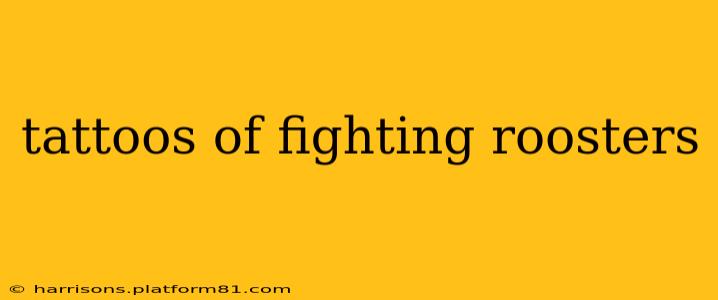Fighting roosters, with their aggressive stance and vibrant plumage, make for striking tattoo subjects. But beyond the aesthetic appeal, these tattoos carry a rich tapestry of symbolism, varying across cultures and individual interpretations. This article explores the diverse meanings behind fighting rooster tattoos, examines popular styles, and answers frequently asked questions surrounding this bold body art choice.
What does a fighting rooster tattoo symbolize?
The symbolism of a fighting rooster tattoo is multifaceted and often depends on the wearer's personal experiences and cultural background. Generally, fighting roosters represent several key themes:
-
Aggression and Courage: The rooster's inherent combativeness is a primary symbol. The tattoo can represent a fierce spirit, a willingness to fight for what you believe in, and unwavering courage in the face of adversity.
-
Masculinity and Strength: Rooster imagery is often associated with masculine energy, strength, power, and dominance. This is particularly relevant in some cultures where the rooster holds a prominent place in mythology and folklore.
-
Independence and Freedom: The rooster's independent nature, often associated with its early morning crowing, can symbolize freedom, self-reliance, and breaking free from constraints.
-
Good Luck and Prosperity: In some Asian cultures, particularly in countries like China and Vietnam, the rooster is associated with good fortune, prosperity, and protection. The tattoo may reflect a desire for these positive outcomes.
-
Warrior Spirit and Resilience: The rooster's tenacity in the face of a fight symbolizes resilience, determination, and a warrior-like spirit. It can represent overcoming challenges and persevering through difficult times.
What are some popular styles for fighting rooster tattoos?
The artistic possibilities for fighting rooster tattoos are vast. The style chosen often reflects the wearer's personality and desired aesthetic. Some popular styles include:
-
Traditional American: Bold outlines, solid colors, and a classic, slightly cartoonish style are hallmarks of this approach. Expect vibrant reds, yellows, and blacks.
-
Realism: Highly detailed and lifelike depictions showcasing the intricate feather patterns and muscular structure of the rooster. These tattoos require a skilled artist and often feature a high level of shading and texture.
-
Geometric: Clean lines, sharp angles, and geometric patterns are incorporated into the rooster's design, creating a modern and stylized look.
-
Tribal: Rooster imagery is integrated into tribal designs, often incorporating traditional patterns and symbolism from various cultures.
Are fighting rooster tattoos only for men?
No, fighting rooster tattoos are not exclusively for men. While traditionally associated with masculine traits, anyone can choose this tattoo design. The symbolism resonates with individuals who identify with the qualities represented, regardless of gender. Women can choose to express their inner strength, courage, and independence through a fighting rooster tattoo just as effectively as men.
What are the cultural implications of fighting rooster tattoos?
The cultural implications of a fighting rooster tattoo can be significant. In some cultures, rooster fighting is a traditional sport with deep-rooted history and cultural significance, while in others, it's viewed as animal cruelty. Understanding the cultural context is crucial before choosing such a tattoo, particularly if traveling internationally. It's important to be aware of how the design might be perceived in different contexts.
How much does a fighting rooster tattoo cost?
The cost of a fighting rooster tattoo varies significantly depending on factors such as the size, complexity, detail, and the artist's experience and location. Smaller, simpler designs will cost less than larger, more intricate pieces. It's always best to consult with several artists in your area to get a detailed quote and understand their pricing structure.
In conclusion, fighting rooster tattoos are powerful and symbolic pieces of body art that go beyond mere aesthetics. Their meaning is deeply personal and varies according to individual experiences and cultural background. Choosing the right artist and style is crucial to creating a tattoo that accurately reflects the wearer's intended message and remains a cherished piece of self-expression for years to come.
